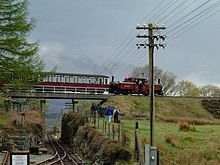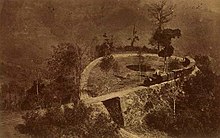Spiral (railway): Difference between revisions
Scriberius (talk | contribs) No edit summary |
|||
| Line 105: | Line 105: | ||
Many [[Multi-storey car park]]s feature such a design as this. |
Many [[Multi-storey car park]]s feature such a design as this. |
||
Slovakia |
|||
== See also == |
== See also == |
||
Revision as of 21:50, 14 March 2007


A spiral (sometimes called a spiral loop) is a technique employed by railways to ascend steep hills.
The railway spiral involves a track which rises on a steady curve until it has completed a 360-degree loop, passing over itself as it gains height. This allows the railway to gain vertical elevation in a relatively short horizontal distance. It is an alternative to a zig-zag, and avoids the need for the trains to stop and reverse direction while ascending. If the train is of sufficient length, it is possible to view the train looping onto itself.
A spiral loop should not be confused with the civil engineering spiral curve used to provide a transition from a tangent into a horizontal circular curve. The civil engineering spiral curve is a curve of uniformly decreasing radius (beginning at infinite and ending at the radius of the circular curve) used to minimize rolling stock sway and also in highway curves for aesthetic reasons.
Calculations
Consider a railway climbing at a gradient of 1 in 40 (2.5%, or 25 m per km). A 360-degree spiral at 350 m radius will add 1100 m to the forward journey and 27 m to the vertical climb. Unless the topography has a suitably shaped hill, the spiral is likely to be in tunnel, creating problems if steam locomotives are employed.
The spiral needs to climb about 6 m in order to bridge itself. With steam locomotives and to a lesser extent with diesel locomotives, the gradient in the tunnel should be less than the ruling grade to avoid problems with fumes and dampness causing the driving wheels to slip.
List of spirals
- Africa
- Australia
- Bethungra Spiral two very short tunnels, downhill track plain at 1 in 40 gradient, uphill track in spiral at 1 in 66 gradient
- Cougal Spiral one short, one long tunnel, single track
- Bulgaria
- Avramovo Template:760mm gauge
- Canada
- Spiral tunnels between Field, BC, and the summit of Kicking Horse Pass, Canadian Pacific Railway
- France
- Sayerce tunnel between Pau (France) and Zaragossa (Spain) in the Pyrenees [1]
- The railway between Nice (France) and Cuneo (Italy) use three spirals.
- Germany
- Rendsburg Viaduct, southern approach. Unique oblong single loop onto the transporter bridge crossing the Kiel Canal
- The Wutachtalbahn had to be built less steep than possible to haul heavy military trains over it, since it was the bypass for the shorter route Singen–Waldshut, which crossed Swiss territory.

- India
- Darjeeling Himalayan Railway (DHR) has three (originally five) loops, of which one is a double spiral. Template:2ftgauge
- Iran
- Numerous spirals through very mountainous regions, mostly entirely in tunnel and single track
- Ireland
- The St. James's Gate Brewery, Dublin, Ireland had an internal 1 ft 10 in gauge railway with a loop in a tunnel to gain height between buildings [2]
- Japan
- Joetsu Line has two spirals
- Hokuriku Main Line between Tsuruga and Shinhikita
- Hisatsu line
- Tosa Kuroshio Railway Nakamura line
- Yurikamome, western approach to the Rainbow Bridge
- Madagascar
- One loop at Anjiro on the main line from Antananrivo to Toamasina
- Myanmar
- Two spirals on the Burmah Mines Railway [3]
- New Zealand
- Raurimu Spiral on the North Island Main Trunk, single track, suitable hill, two short tunnels
- Norway
- South Korea
- between Bangok station and Chiak station on Jungang Line - one loop, single track. New double track tunnel is under construction to replace loop tunnel.
- between Jukryeong station and Heuibangsa station on Jungang Line - one loop, single track.
- Spain
- Cargol Tunnel on the Ripoll - La Tour de Carol (France) line
- Switzerland
- Gotthardbahn has five spirals and two turns, entirely in tunnel, double track, standard gauge
- Albulabahn has several spiral tunnels, single track, metre gauge
- RhB has an open spiral mainly on a bridge (Berninabahn, near Brusio), single track, metre gauge
- Former Furka-Oberalp-Bahn, now heritage railway Dampfbahn Furka-Bergstrecke, has one on top, single track, metre gauge, catenary removed
- Former Furka-Oberalp-Bahn, now Matterhorn-Gotthard-Bahn, between Grengiols and Laax, single track, metre gauge, cog rail, entirely in tunnel
- Taiwan
- Dulishan loop is a triple spiral (two clockwise and one counter-clockwise), Alishan (阿里山) Forest Railway, narrow gauge, single track
- United Kingdom
- Dduallt Loop, Ffestiniog Railway in Wales, Template:1ft11.5in gauge
- The line from Moorswater cement terminal, through Coombe Junction and Liskeard on the Looe Valley Line and on over Moorswater Viaduct forms a complete spiral, climbing up to join the main line at Liskeard. However, not all parts of this are used for passenger working.
- United States
- California, Williams Loop
- California, Tehachapi Loop
- Colorado, Georgetown Loop
- Ophir Loop - Rio Grande Southern Railroad - Template:3ft gauge
Spirals are not generally used on tramways (street running or reserved track) or light rail lines because trams traditionally have all wheels powered, so can climb much steeper direct gradients than railways.
Roads
Roads sometimes use a spiral to gain height in a confined space:
- Cahill Expressway, Sydney, New South Wales, Australia.
- Lincoln Tunnel, approach road to west portal, Weehawken, New Jersey, USA.
- Iron Mountain Road, Custer State Park, South Dakota, USA.
Many Multi-storey car parks feature such a design as this.
Slovakia
See also
External link
This list is incomplete; you can help by adding missing items. |
